Coffee stands as one of the most beloved beverages worldwide, transcending borders, cultures, and lifestyles. Its rich aroma, diverse flavors, and stimulating effects have made it a staple in the daily lives of millions. Originating from the ancient coffee forests of Ethiopia, coffee has woven its way through history, becoming a global phenomenon. Today, it is more than just a morning ritual or an energy booster; coffee symbolizes a moment of pause, a tradition, and for many, an art form.
Who Drinks the Most Coffee in the World?
Finland typically leads the world in coffee consumption per capita, with Nordic countries often occupying the top spots in such rankings. On average, Finns consume around 12 to 13 kilograms of coffee per person per year. This high consumption is influenced by cultural practices, the cold climate, and the legal work breaks that many Finns utilize to enjoy a cup of coffee.
The importance of coffee in various cultures cannot be overstated. In Italy, espresso is a way of life, encapsulating the Italian ethos of quality and simplicity. The ritual of preparing and savoring a cup of espresso reflects the Italian’s appreciation for the finer things in life, often enjoyed in the company of friends and family. Similarly, in Turkey, coffee is central to social life and hospitality, with Turkish coffee being served with a distinct preparation method that has been recognized by UNESCO as an intangible cultural heritage.
In the Nordic countries, which consistently rank among the highest in coffee consumption per capita, coffee is integral to social gatherings and work breaks, embodying the concept of “fika” in Sweden—a cherished break for coffee and conversation. Meanwhile, in Ethiopia, the birthplace of coffee, the traditional coffee ceremony is a significant communal event, involving the roasting of beans, brewing in a clay pot, and sharing among participants, symbolizing unity and friendship.
Coffee’s influence extends beyond its taste and aroma; it has become a vehicle for social interaction, a muse for artists, and a critical component of economic systems in producing countries. The global coffee industry also reflects a complex web of trade relationships, sustainability concerns, and cultural exchanges, making coffee a unique lens through which to explore global dynamics.
As we delve into the world of coffee consumption, we uncover not only the patterns and trends that define its popularity but also the profound impact coffee has on societies and cultures around the globe. Coffee’s journey from bean to cup encapsulates a blend of tradition, innovation, and connection, making it a truly universal beverage.
The Global Coffee Scene
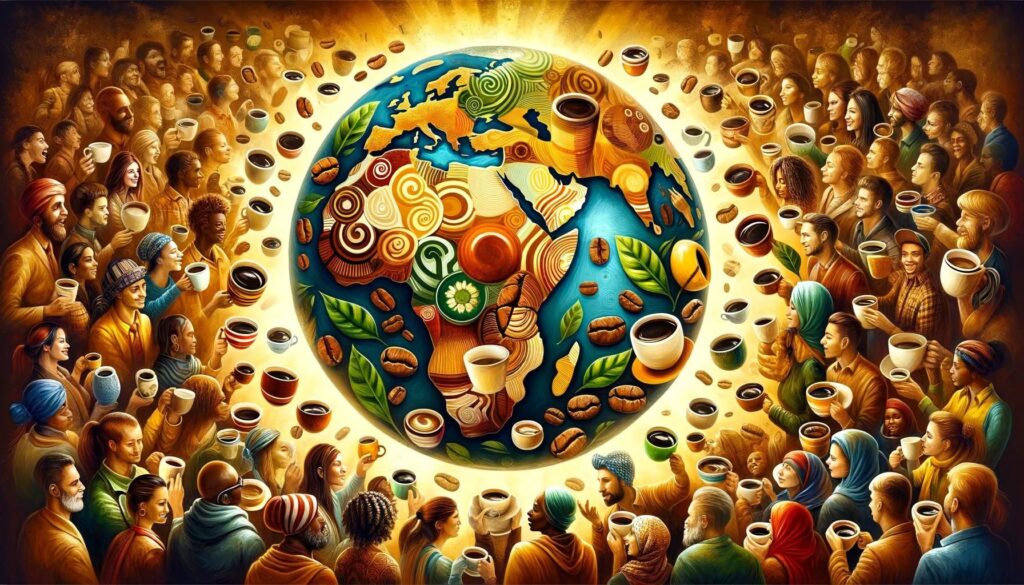
The global coffee scene is a vibrant tapestry that illustrates the beverage’s widespread appeal and cultural significance. Coffee consumption has grown steadily over the years, making it one of the most consumed beverages worldwide, second only to water in some statistics. This section explores the magnitude of global coffee consumption, the role coffee plays in bridging cultures, and a brief history of how coffee became the global phenomenon it is today.
Overview of Global Coffee Consumption
Globally, coffee consumption is on the rise, with an estimated 2 billion cups of coffee consumed every day. The demand for coffee varies significantly from one region to another, influenced by cultural preferences, economic factors, and social practices. While countries in North America and Europe traditionally lead in per capita coffee consumption, emerging markets in Asia and Africa are experiencing rapid growth. This surge is attributed to increasing urbanization, a growing middle class, and changing lifestyles, particularly among the younger population.
The Role of Coffee in Connecting Cultures
Coffee has a unique ability to bring people together, serving as a common ground across different cultures. Coffee shops, whether in bustling cities or small towns, often become cultural hubs where people gather, exchange ideas, and share moments. The coffee culture in each country adds a local flavor to this global drink, from the espresso bars of Italy to the specialty coffee shops of Japan, showcasing the diversity of coffee traditions.
In many ways, coffee has become a universal language, facilitating cultural exchange and understanding. Specialty coffee events, barista competitions, and coffee festivals further highlight the global community built around coffee appreciation and craftsmanship. Through these gatherings, coffee enthusiasts and professionals share knowledge, techniques, and stories, fostering a sense of global camaraderie.
Brief History of Coffee and Its Spread Around the World
The history of coffee is as rich and complex as the beverage itself. Originating in Ethiopia, coffee’s energizing effects were initially discovered by goat herders in the region. The cultivation and consumption of coffee began to spread in the Arabian Peninsula in the 15th century, where it played a significant role in religious and social gatherings.
By the 17th century, coffee had made its way to Europe, initially facing resistance but quickly becoming popular as a social drink in coffee houses, which were often centers of intellectual exchange. These coffee houses earned the moniker “penny universities” in England due to the rich conversations that could be had for the price of a cup of coffee.
The colonial expansion of European powers brought coffee to new regions, including the Caribbean, South America, and Asia, where it became a major cash crop. Today, coffee cultivation is a vital economic activity in over 70 countries, primarily located in the equatorial regions known as the Bean Belt.
The spread of coffee around the world is a testament to its ability to adapt and thrive in various cultures. From its humble beginnings to becoming a global commodity, coffee has influenced economies, societies, and traditions, making it a significant thread in the fabric of human history.
Top Coffee-Consuming Countries
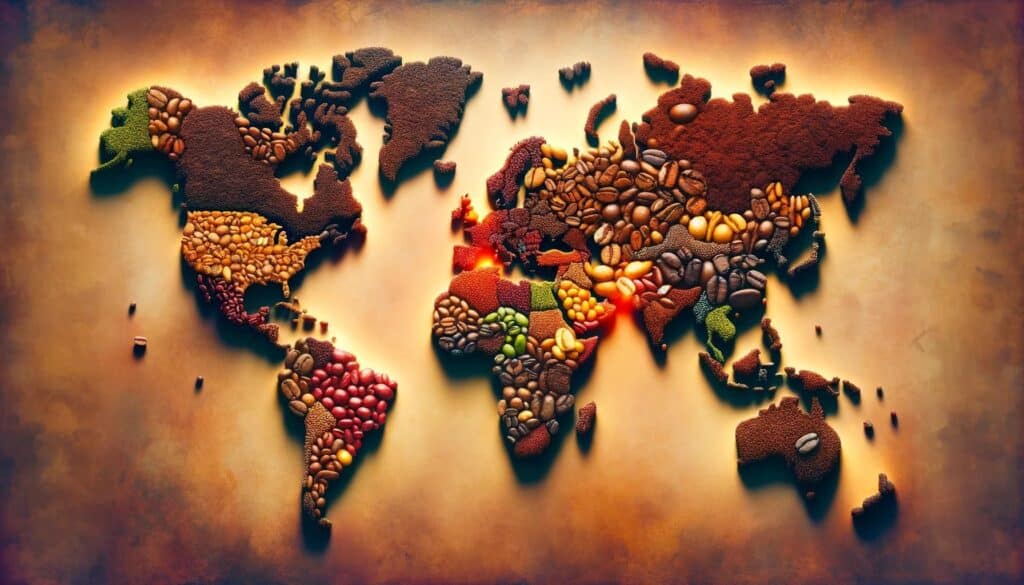
The landscape of global coffee consumption is diverse and dynamic, with certain countries leading the charge in both per capita consumption and total national consumption. Understanding the top coffee-consuming countries requires looking at two key metrics: per capita consumption, which provides insight into the coffee drinking habits of the average citizen, and total national consumption, which reflects the overall market size. Additionally, the distinction between coffee-producing and coffee-consuming countries offers fascinating insights into the global coffee trade.
Criteria for Measuring Coffee Consumption
Per Capita Consumption
Per capita coffee consumption is calculated by dividing the total coffee consumed in a country by its population. This metric is crucial for understanding how integral coffee is to the daily life of an individual in different countries. It highlights countries where coffee is a significant part of the culture and lifestyle, regardless of the country’s size or coffee production status.
Total National Consumption
Total national consumption measures the total volume of coffee consumed within a country. This metric provides perspective on the overall demand for coffee in larger markets and is influenced by population size. Countries with large populations may have high total coffee consumption even if their per capita consumption is moderate.
Top Coffee-Consuming Countries: A Snapshot
Countries in the Nordic region, such as Finland, Norway, Iceland, Denmark, and Sweden, often top the charts in per capita coffee consumption. The coffee culture in these countries is deeply ingrained, with coffee playing a central role in social interactions and daily routines. Despite their relatively small populations, the high per capita consumption rates highlight the importance of coffee in these societies.
When it comes to total national consumption, the United States leads the way, followed by countries like Brazil and Germany. The U.S.’s position is primarily due to its large population and the widespread popularity of coffee across various demographics. Brazil, on the other hand, is unique as it is both a top producer and consumer, highlighting the domestic love for coffee in one of the largest coffee-producing nations.
The Distinction Between Producing and Consuming Countries
The global coffee market is characterized by a clear distinction between producing and consuming countries. Coffee-producing countries are primarily located in the equatorial region known as the “Coffee Belt,” where the climate is ideal for coffee cultivation. Countries like Brazil, Vietnam, Colombia, and Ethiopia are among the top coffee producers.
Consuming countries, on the other hand, are spread across the globe, with a significant concentration in Europe and North America. Many of the top consuming countries, particularly those in Europe, do not produce coffee due to climatic limitations but have a strong coffee culture and high demand for the beverage.
This distinction underscores the complex global trade dynamics of the coffee industry, where beans travel across continents from regions of production to major markets of consumption. The journey of coffee from bean to cup is a global affair, involving a multitude of cultures, economies, and traditions, making it one of the most internationally beloved commodities.
Per Capita Leaders: Unraveling the Surprises
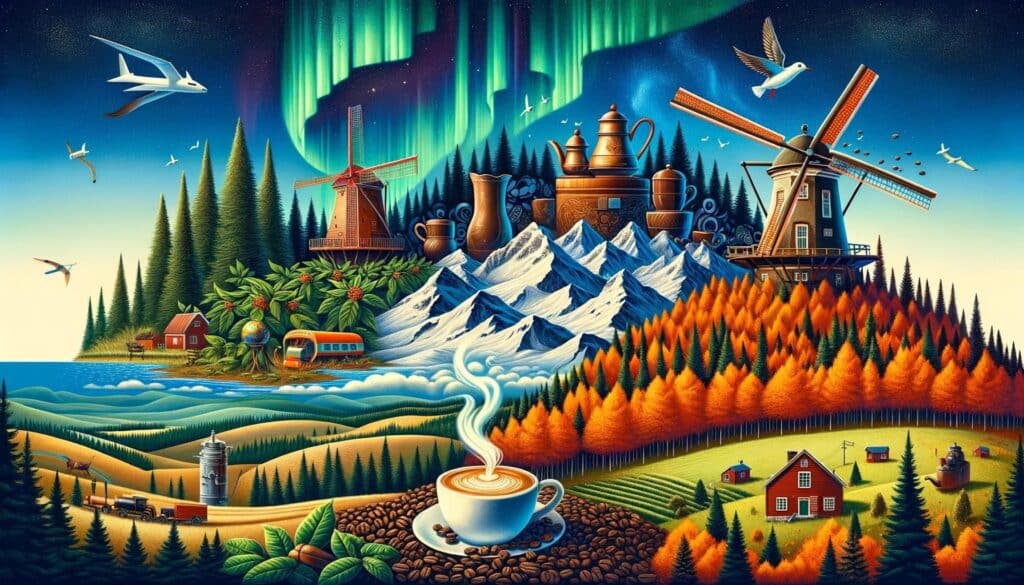
The list of per capita coffee consumption leaders often contains surprises, particularly with the Nordic countries leading the pack. This phenomenon can be attributed to several cultural, historical, and social factors that make coffee more than just a beverage in these societies. Let’s take a closer look at the coffee cultures in Finland and Sweden, as well as other notable mentions like the Netherlands, Switzerland, and Canada.
Nordic Countries: A Closer Look
Finland’s Coffee Culture
Finland stands out for its remarkably high coffee consumption, with Finns consuming more coffee per capita than any other nation. This deep-rooted coffee culture is characterized by several unique practices and preferences. For instance, light roast coffee is overwhelmingly popular, reflecting Finns’ preference for a milder, more caffeine-rich cup. Coffee in Finland transcends mere consumption; it’s a pivotal part of social customs, workplace breaks, and family gatherings. The Finnish coffee break, known as “kahvitauko,” is a testament to the nation’s love for coffee, offering a moment for relaxation and socialization.
Sweden and the Tradition of “Fika”
In Sweden, coffee is integral to the cherished tradition of “fika” — a concept that involves taking a pause in the day to enjoy coffee and pastries with friends, family, or colleagues. Fika is deeply embedded in Swedish culture, symbolizing a deliberate slowdown in one’s day to appreciate the moment and the company of others. This tradition underscores the social aspect of coffee consumption in Sweden, making it an essential daily ritual.
Other Notable Mentions
Netherlands
The Netherlands boasts a vibrant coffee culture, with Dutch consumers favoring quality and sustainability in their coffee choices. Coffee houses and cafés play a significant role in Dutch social life, serving as popular venues for both casual meetings and remote work. The preference for single-origin and ethically sourced beans reflects the Dutch commitment to global coffee sustainability and quality.
Switzerland
Switzerland is renowned for its high coffee standards and consumption. Swiss coffee culture is characterized by a penchant for precision and quality, with a strong preference for espresso and espresso-based drinks. The country’s coffee scene is also distinguished by its innovative approach to coffee, including the development of capsule coffee systems that have gained worldwide popularity.
Canada
Canada’s coffee culture is marked by its diversity and the widespread popularity of coffee chains, alongside a growing interest in specialty coffee. Canadian coffee consumers enjoy a variety of coffee styles, from the traditional drip coffee to artisanal espresso drinks. The country’s cold climate contributes to the high consumption levels, with coffee serving as a comforting warm beverage during the long winter months.
These countries’ leading positions in per capita coffee consumption reflect not only their love for coffee but also the diverse ways in which coffee is woven into the fabric of their societies. From Finland’s coffee breaks to Sweden’s fika and beyond, coffee serves as a catalyst for social interaction, a hallmark of hospitality, and a daily ritual, highlighting the beverage’s universal appeal and cultural significance.
Total Consumption Titans

In the realm of total coffee consumption, a few countries stand out for their sheer volume of coffee intake, reflecting not just a cultural affinity for coffee but also the size and dynamics of their markets. The United States, Brazil, Germany, and Italy each have unique coffee cultures and roles within the global coffee industry, from trendsetting to maintaining deep-rooted traditions.
United States: A Nation Fueled by Coffee
The United States emerges as a titan in total coffee consumption, thanks in part to its large population and the integral role coffee plays in American daily life. The U.S. coffee market is characterized by a wide variety of consumption habits, ranging from the traditional drip coffee at breakfast to the afternoon espresso-based drinks popularized by coffee shop chains.
Trends in Consumption: Specialty vs. Traditional Coffee
The U.S. has seen a significant shift towards specialty coffee, with consumers increasingly interested in the quality, origin, and method of preparation of their coffee. This trend towards premiumization reflects a growing segment of the population that values artisanal coffee experiences and is willing to pay more for higher quality, sustainably sourced beans. However, traditional coffee, characterized by pre-ground coffee brewed at home or in the office, continues to hold a substantial share of the market, indicating a diverse palette among American coffee drinkers.
Brazil: Double Identity as a Top Producer and Consumer
Brazil enjoys a unique position in the coffee world, being the largest coffee producer globally and one of the top consumers of coffee. This dual identity provides a fascinating insight into Brazil’s coffee culture, which is as diverse as its geography. Brazilians have a strong preference for cafezinho, a small, strong cup of coffee served throughout the day, reflecting the nation’s love for coffee in its purest form. The abundance of locally grown coffee means that Brazilians have access to some of the best beans in the world, contributing to the country’s high consumption rates.
Germany and Italy: European Love for Coffee
Germany
Germany stands out for its high total coffee consumption, driven by a robust coffee culture that values both traditional coffeehouses and the convenience of home brewing. The country has a strong market for both filtered coffee and espresso-based drinks, with a growing interest in sustainable and fair-trade coffee options. The German coffee scene is also notable for its Kaffee und Kuchen (coffee and cake) tradition, a social ritual that mirrors the coffee cultures in other parts of the world.
Italy
Italy’s contribution to the global coffee culture cannot be overstated, with the country being the birthplace of espresso and many coffee-based drinks that have gained international fame. Italian coffee culture is deeply ingrained in daily life, with bars serving as community hubs where espresso is consumed quickly and frequently throughout the day. Despite not being one of the largest in terms of total consumption due to its smaller population, Italy’s influence on coffee culture and consumption patterns worldwide is immense.
These Total Consumption Titans, each with their distinct coffee cultures and preferences, underscore the varied and dynamic nature of global coffee consumption. From the specialty coffee shops of the United States to the traditional cafezinhos of Brazil and the iconic espresso bars of Italy, coffee continues to be a significant and unifying element of daily life and culture around the world.
Factors Influencing High Coffee Consumption

High coffee consumption around the world can be attributed to a myriad of factors, ranging from climatic and geographical conditions to cultural practices and the evolving role of coffee in the workplace and public spaces. These factors interact in complex ways, influencing not only how much coffee is consumed but also how it is consumed and integrated into daily life.
Climate and Geography: Their Influence on Consumption Habits
The climate and geography of a region can significantly influence coffee consumption habits. In countries with colder climates, such as those in the Nordic region and Canada, coffee is often consumed throughout the day as a way to stay warm and alert. The long, dark winters in these regions contribute to the high per capita coffee consumption, as residents seek comfort and warmth in a cup of coffee.
Conversely, in warmer climates, coffee consumption may follow different patterns, often influenced by the availability of fresh, locally grown beans. In coffee-producing countries, the proximity to coffee plantations often means that consumers have a preference for fresh, high-quality beans, which can influence the popularity of certain types of coffee drinks and brewing methods.
Cultural Practices: How Tradition Shapes Consumption
Cultural practices and traditions play a pivotal role in shaping coffee consumption habits. In Italy, for example, espresso is not just a coffee drink; it’s an integral part of the social fabric, consumed at bars throughout the day as a quick pause from the hustle and bustle. Similarly, in Ethiopia, coffee is at the heart of a traditional coffee ceremony that involves roasting, grinding, and brewing coffee in a communal setting, emphasizing the social aspect of coffee consumption.
In many cultures, coffee consumption is tied to specific rituals, times of day, or social settings, illustrating how deeply embedded coffee is in the cultural identity of various societies. These traditions influence not only the amount of coffee consumed but also the manner in which it is enjoyed.
The Role of Coffee in the Workplace
Coffee plays a crucial role in the workplace, serving as a stimulant that can enhance focus and productivity. The coffee break is a widely observed practice in offices around the world, providing employees with a moment of respite and an opportunity for informal interaction with colleagues. In some cultures, such as in Sweden with the “fika,” these coffee breaks are institutionalized as part of the workday, reinforcing the social value of coffee in fostering workplace camaraderie and collaboration.
The availability of coffee in the workplace, whether through traditional coffee machines, espresso makers, or even on-site coffee shops, reflects the importance of coffee in maintaining a productive and engaging work environment.
The Impact of Coffee Shops and Chains on Consumption Trends
The proliferation of coffee shops and chains has significantly influenced coffee consumption trends globally. These establishments serve as social spaces where people can work, socialize, or simply enjoy a moment of solitude with a cup of coffee. The rise of specialty coffee shops has introduced consumers to a wide variety of coffee types, brewing methods, and flavors, raising awareness and appreciation for high-quality coffee.
Furthermore, coffee chains have played a key role in popularizing certain coffee drinks and making them accessible to a broader audience. The global spread of these chains has led to a homogenization of coffee culture in some respects, but it has also spurred interest in local coffee traditions and specialty coffee as consumers seek out unique and authentic coffee experiences.
In sum, the factors influencing high coffee consumption are diverse and multifaceted, reflecting the complex role that coffee plays in different societies. From climate and geography to cultural practices and the modern workplace, coffee’s significance extends far beyond its role as a beverage, embodying traditions, social interactions, and daily rituals across the globe.
Coffee Consumption Trends
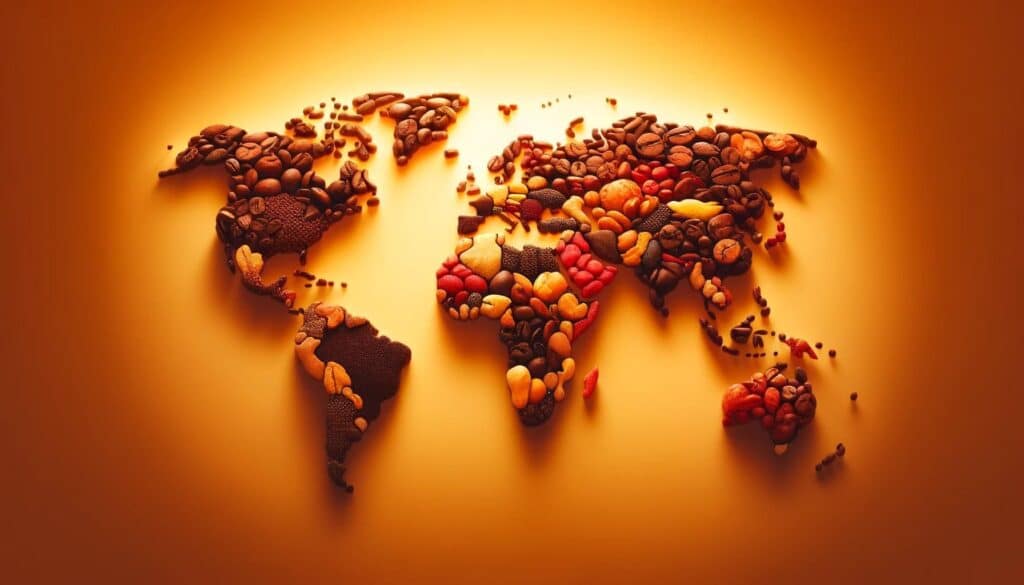
The landscape of coffee consumption has evolved significantly in recent years, shaped by emerging trends that reflect changing consumer preferences, health considerations, and technological advancements. These trends offer insight into the future direction of the coffee industry and how people around the world engage with this beloved beverage.
The Rise of Specialty Coffee
Specialty coffee has seen a meteoric rise, driven by consumers’ growing interest in the quality, origin, and unique characteristics of coffee beans. This trend is characterized by a focus on artisanal brewing methods, direct trade, and the overall transparency of the coffee supply chain. Consumers are increasingly willing to pay a premium for coffees that offer a unique taste experience or that adhere to ethical and sustainable sourcing practices.
Coffee enthusiasts are also showing a keen interest in learning about different coffee varieties, the impact of terroir on flavor, and the art of coffee tasting, similar to wine. This has led to the proliferation of specialty coffee shops and roasteries that cater to this discerning market, offering curated coffee experiences that go beyond the conventional cup.
Health Consciousness and Its Impact on Coffee Drinking Habits
Health consciousness is another significant trend impacting coffee consumption habits. As consumers become more aware of the health benefits and potential downsides of coffee consumption, there is a growing demand for healthier coffee options. This includes a rise in the popularity of organic and natural coffees, as well as those with added health benefits, such as antioxidant-rich or vitamin-infused coffees.
Furthermore, there’s an increasing trend towards alternatives to traditional dairy milk in coffee, such as almond, oat, and soy milk, driven by both health considerations and environmental concerns. The interest in decaffeinated options and low-acid coffee varieties also reflects the desire for a healthier coffee drinking experience, accommodating those with sensitivities or those looking to reduce their caffeine intake without giving up coffee.
The Influence of Technology on Coffee Consumption
Technology has had a profound impact on coffee consumption, transforming how coffee is brewed, consumed, and enjoyed. Home brewing technology has advanced significantly, with sophisticated machines and gadgets that allow consumers to replicate barista-quality coffee at home. This includes everything from smart coffee makers that can be controlled via smartphone apps to single-serve pod machines and high-precision espresso machines.
On the consumer side, apps and online platforms have made it easier than ever to discover new coffee brands, order specialty beans directly from roasters, and even learn brewing techniques through online tutorials and courses. Social media platforms have also played a crucial role in the spread of coffee culture, with influencers and coffee enthusiasts sharing their coffee experiences, reviews, and recipes with a global audience.
Moreover, technology is influencing the coffee supply chain, with blockchain and traceability solutions providing consumers with more information about the origin and journey of their coffee beans. This not only enhances transparency but also supports ethical and sustainable coffee production practices.
These trends in specialty coffee, health consciousness, and technology illustrate the dynamic nature of the coffee industry and the evolving preferences of coffee drinkers. As these trends continue to unfold, they will shape the future of coffee consumption, reflecting broader societal shifts towards quality, health, and sustainability.
Challenges and Sustainability
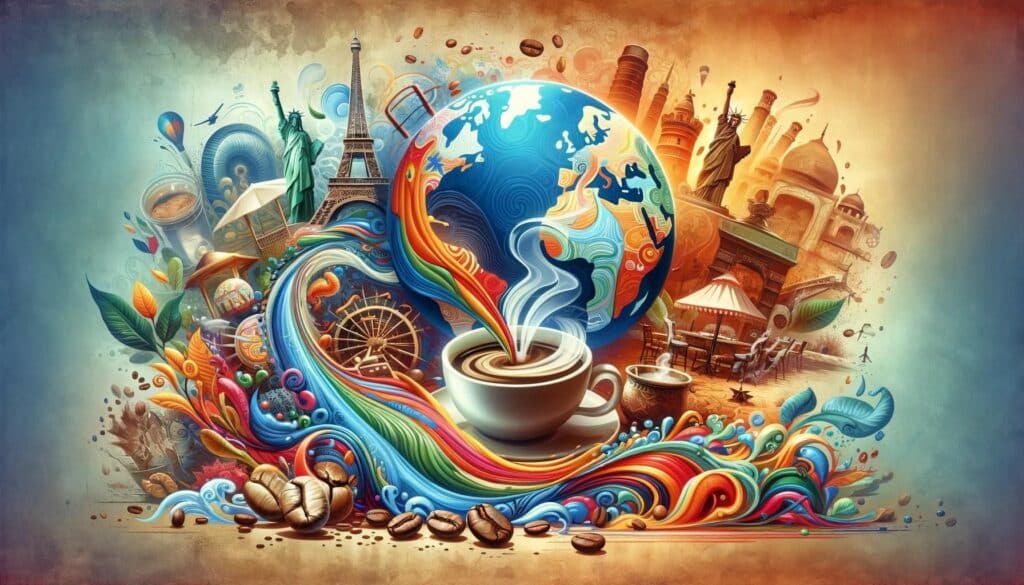
The surging global demand for coffee brings to the forefront significant challenges related to sustainability and the environmental impact of coffee production and consumption. Addressing these challenges is crucial for ensuring the long-term viability of the coffee industry and the ecosystems it depends upon. Let’s delve into the environmental implications of high coffee consumption, the ongoing efforts towards sustainability, and emerging trends that could shape the future of coffee.
Environmental Impact of High Coffee Consumption
The environmental impact of coffee production is multifaceted, encompassing deforestation, water use, and pollution from pesticides and fertilizers. High coffee consumption exacerbates these issues, particularly as demand leads to the expansion of coffee farming into sensitive ecological areas. Deforestation not only destroys habitats but also contributes to climate change, while the intensive use of water and agrochemicals can pollute waterways and deplete local water resources.
Moreover, the waste generated from coffee consumption, including single-use cups, pods, and packaging, adds to the environmental footprint of coffee. The challenge lies in balancing the growing global appetite for coffee with the need to preserve the natural environment and ensure the well-being of coffee-growing communities.
Efforts Towards Sustainable Coffee Consumption
Recognizing the environmental and social challenges posed by coffee production, there are concerted efforts across the industry to promote sustainable practices. These include:
- Certification and Labeling Schemes: Programs like Fair Trade, Rainforest Alliance, and Organic certification aim to promote environmentally friendly and socially responsible coffee production. These certifications encourage practices that protect the environment and ensure fair compensation for farmers.
- Direct Trade and Transparency: Many specialty coffee roasters engage in direct trade, buying straight from farmers at a fair price and fostering transparency in the coffee supply chain. This not only ensures a higher quality product but also supports sustainable practices at the farm level.
- Technological Innovations: Advances in agricultural technology, including precision farming and sustainable irrigation methods, help reduce the environmental footprint of coffee farming. Similarly, innovations in packaging and brewing technology aim to minimize waste and energy consumption.
- Consumer Awareness and Action: Consumers play a crucial role in driving demand for sustainable coffee. By choosing sustainably sourced and certified coffees, using reusable cups, and supporting ethical brands, consumers can contribute to a more sustainable coffee industry.
The Future of Coffee: Trends to Watch
Looking ahead, several trends are poised to influence the sustainability of the coffee industry:
- Climate Change Adaptation: With coffee being highly sensitive to climate conditions, research and development of climate-resilient coffee varieties will become increasingly important. This includes breeding programs focused on developing strains that can withstand temperature variations, pests, and diseases.
- Circular Economy Practices: Efforts to apply circular economy principles to the coffee industry, such as composting coffee waste and repurposing spent coffee grounds, are gaining traction. These practices not only reduce waste but also create value from by-products of coffee production and consumption.
- Renewed Focus on Localism: The trend towards localism, including support for local coffee roasters and the promotion of locally grown coffee (where possible), helps reduce the carbon footprint associated with coffee transportation and supports local economies.
- Technological Innovations in Consumption: The development of more sustainable brewing methods and eco-friendly coffee machines, as well as initiatives to recycle coffee pods and packaging, will continue to address the environmental impact of coffee consumption.
As the coffee industry navigates these challenges, the future of coffee will increasingly hinge on its ability to innovate and adapt in the face of environmental concerns and changing consumer expectations. The concerted efforts of producers, consumers, and governments will be essential in steering the coffee industry towards a more sustainable and environmentally friendly path.
Conclusion
In exploring the multifaceted world of coffee consumption, several key findings emerge, painting a picture of a beverage that is much more than just a morning pick-me-up. Coffee’s journey from bean to cup encapsulates a complex interplay of cultural traditions, economic dynamics, and global trends, highlighting its role as a universal connector and a reflection of societal values and shifts.
Summary of Key Findings
- Global Coffee Consumption: Coffee remains one of the most beloved beverages worldwide, with Nordic countries leading in per capita consumption and the United States dominating in total consumption. These patterns reveal not only a global appetite for coffee but also the diverse ways in which it is integrated into various cultures.
- Cultural Significance: The cultural practices surrounding coffee, from Finland’s coffee breaks to Italy’s espresso bars, showcase its role in fostering social interactions and community. Coffee’s ability to adapt to and reflect local traditions underscores its deep cultural significance.
- Sustainability Challenges: The environmental impact of coffee production and consumption presents significant challenges, including deforestation, water use, and waste. However, efforts toward sustainable coffee consumption, including certification schemes and technological innovations, offer paths forward.
- Emerging Trends: The rise of specialty coffee, health consciousness, and the influence of technology on coffee consumption are shaping the future of the industry. These trends reflect a growing demand for quality, transparency, and sustainability in the coffee sector.
The Cultural Significance of Coffee Beyond Mere Numbers
Coffee transcends its status as a commodity, embodying rituals, traditions, and moments of connection. Its cultural significance is evident in the daily lives of millions around the globe, serving as a symbol of hospitality, a catalyst for conversation, and a source of inspiration. The universal appeal of coffee lies not just in its caffeine content but in its ability to bring people together, reflecting shared experiences and diverse cultural identities.
Final Thoughts on the Future of Coffee Consumption Globally
The future of coffee consumption globally is poised at the intersection of tradition and innovation. As the industry grapples with sustainability challenges, the evolution of coffee consumption will likely be marked by a continued emphasis on ethical sourcing, environmental stewardship, and innovation in brewing technologies. Consumers’ growing sophistication and awareness will drive demand for coffees that not only taste good but also do good for the world.
Moreover, as coffee cultures continue to blend and influence each other, we can expect a richer, more diverse global coffee landscape to emerge. This will include a fusion of traditional practices with new consumption trends, offering exciting possibilities for the next generation of coffee drinkers.
In conclusion, the story of coffee is continuously unfolding, shaped by historical roots, cultural significance, and forward-looking trends. Its journey from a humble bean to a global phenomenon encapsulates the complexities and joys of human experience, promising a future where coffee continues to connect, inspire, and evolve with us.
Frequently Asked Questions About Coffee Consumption
1. Which country consumes the most coffee per capita?
Finland consistently ranks as the top country for coffee consumption per capita, with its residents consuming more coffee than those of any other country. The average Finn consumes several cups of coffee daily, favoring light roasts and enjoying coffee as a central part of their daily rituals and social gatherings.
2. What are the main differences between specialty coffee and traditional coffee?
Specialty coffee refers to high-quality beans that have been carefully sourced, roasted, and brewed to enhance their unique flavor profiles. It emphasizes the origin, artisanal methods of production, and the distinct characteristics of the coffee. Traditional coffee, on the other hand, may involve a broader range of bean qualities and is often produced and consumed in larger quantities, with a focus on consistency and accessibility rather than the distinctiveness of flavor.
3. How does coffee consumption impact health?
Moderate coffee consumption is associated with several health benefits, including a lower risk of certain diseases such as Parkinson’s, type 2 diabetes, and some forms of cancer. Coffee is rich in antioxidants, which can help protect against cell damage. However, excessive consumption can lead to negative effects, such as increased heart rate, high blood pressure, and sleep disturbances, particularly in individuals sensitive to caffeine.
4. What efforts are being made to make coffee consumption more sustainable?
Efforts to promote sustainable coffee consumption include the development of certification programs like Fair Trade, Organic, and Rainforest Alliance, which encourage environmentally friendly farming practices and fair compensation for coffee producers. There is also a growing trend towards direct trade practices, sustainable packaging solutions, and the use of technology to reduce the environmental footprint of coffee production and consumption.
5. What is the future of coffee consumption likely to look like?
The future of coffee consumption is expected to be characterized by a continued focus on sustainability, quality, and innovation. Consumers will likely continue to show interest in specialty coffees and unique brewing methods, alongside a growing concern for the environmental and social impact of coffee production. Technological advancements will further transform how coffee is brewed, purchased, and enjoyed, making high-quality coffee more accessible while also addressing sustainability challenges.
References and Further Reading
- World Population Review. (n.d.). Coffee consumption by country 2023. Retrieved from https://worldpopulationreview.com/country-rankings/coffee-consumption-by-country
- World Atlas. (n.d.). Top 10 coffee consuming nations. Retrieved from https://www.worldatlas.com/articles/top-10-coffee-consuming-nations.html
- WiseVoter. (n.d.). Coffee consumption by country. Retrieved from https://wisevoter.com/country-rankings/coffee-consumption-by-country/
- Yahoo Finance. (n.d.). Top 20 countries with the highest coffee consumption. Retrieved from https://finance.yahoo.com/news/top-20-countries-highest-coffee-130151364.html






